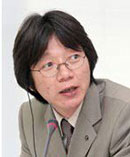Abe's war shrine visit tests China-US cooperation
- By Liu Junhong
 0 Comment(s)
0 Comment(s) Print
Print E-mail chinausfocus.com, January 3, 2014
E-mail chinausfocus.com, January 3, 2014
On 26 December 2013, the anniversary of his second administration, Shinzo Abe made a high-profile visit to the Yasukuni Shrine first thing in the morning. In the press conference he gave afterwards, Abe said that the visit fulfilled his long-cherished wish. His action and remarks shocked the world, disappointed the United States and infuriated China and the Republic of Korea. At a time when China is focused on domestic reform and opening-up, the war shrine visit puts China-Japan relations in deep freeze and disturbs the geometry of power in the western Pacific.
|
|
|
Liu Junhong, Research fellow at the Chinese Institute of Contemporary International Relations |
Tension between the two neighbors goes back to 2010, when China overtook Japan as the world’s second largest economy. In September of that year, Tokyo engineered a boat collision off the DiaoyuIslands. Since then, the relationship has been sour and increasingly confrontational. On 11 September 2012, the Noda administration broke the decades-long understanding to shelve territorial disputes over the DiaoyuIslands by announcing their “nationalization”, a move that accentuated Sino-Japanese disagreement. Against this backdrop, Abe was elected Prime Minister for the second time and his party subsequently gained control of both houses of the Diet. The formation of a long-term and stable government gave Abe enough political capital to exacerbate Tokyo’s antagonism with Beijing.
Once in office, Abe pursued “Abenomics”, a concept first floated during his first administration. He followed the example of the United States and resorted to “quantitative easing”, keeping the Japanese yen down and inflating asset prices. He also adopted mercantilist policies and created the illusion of an economic revival, thus boosting support for his administration and earning the capital to stay in power for a long time.
In the course of 12 months, Abe has visited the United States, Russia, Turkey, Europe and all ten members of the Association of Southeast Asian Nations (ASEAN). During these visits, he sought to secure natural resources, improve Japan’s geostrategic standing and seize a greater market share for Japanese products. He tried to portray Japan as a “proactive contributor to international peace” and paint himself as a world statesman. He cultivated close ties with China’s neighbors, jumped on the bandwagon of the US rebalance to Asia, reveled in “US+Japan+1” or “Japan+1” cooperation and expanded “2+2” arrangements with some countries – all in an attempt to encircle China. He sought to create an impression that the United States is in decline and China is a newcomer to the international scene, which leaves Japan as the main player. He also went out of his way to burnish his reputation as a hard-liner and heir to the right-wing nationalism of Kishi Nobusuke (his grandfather) and the diplomatic strategy of Abe Shintaro (his father) as well as the conservatism of Ronald Reagan.






